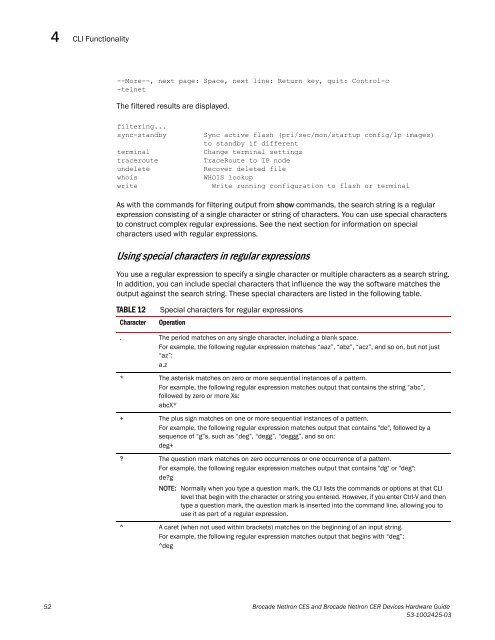Brocade Netiron CES and Brocade Netiron CER Devices Hardware ...
Brocade Netiron CES and Brocade Netiron CER Devices Hardware ...
Brocade Netiron CES and Brocade Netiron CER Devices Hardware ...
Create successful ePaper yourself
Turn your PDF publications into a flip-book with our unique Google optimized e-Paper software.
4<br />
CLI Functionality<br />
--More--, next page: Space, next line: Return key, quit: Control-c<br />
-telnet<br />
The filtered results are displayed.<br />
filtering...<br />
sync-st<strong>and</strong>by Sync active flash (pri/sec/mon/startup config/lp images)<br />
to st<strong>and</strong>by if different<br />
terminal Change terminal settings<br />
traceroute TraceRoute to IP node<br />
undelete Recover deleted file<br />
whois WHOIS lookup<br />
write Write running configuration to flash or terminal<br />
As with the comm<strong>and</strong>s for filtering output from show comm<strong>and</strong>s, the search string is a regular<br />
expression consisting of a single character or string of characters. You can use special characters<br />
to construct complex regular expressions. See the next section for information on special<br />
characters used with regular expressions.<br />
Using special characters in regular expressions<br />
You use a regular expression to specify a single character or multiple characters as a search string.<br />
In addition, you can include special characters that influence the way the software matches the<br />
output against the search string. These special characters are listed in the following table.<br />
TABLE 12 Special characters for regular expressions<br />
Character Operation<br />
. The period matches on any single character, including a blank space.<br />
For example, the following regular expression matches “aaz”, “abz”, “acz”, <strong>and</strong> so on, but not just<br />
“az”:<br />
a.z<br />
* The asterisk matches on zero or more sequential instances of a pattern.<br />
For example, the following regular expression matches output that contains the string “abc”,<br />
followed by zero or more Xs:<br />
abcX*<br />
+ The plus sign matches on one or more sequential instances of a pattern.<br />
For example, the following regular expression matches output that contains "de", followed by a<br />
sequence of “g”s, such as “deg”, “degg”, “deggg”, <strong>and</strong> so on:<br />
deg+<br />
? The question mark matches on zero occurrences or one occurrence of a pattern.<br />
For example, the following regular expression matches output that contains "dg" or "deg":<br />
de?g<br />
NOTE: Normally when you type a question mark, the CLI lists the comm<strong>and</strong>s or options at that CLI<br />
level that begin with the character or string you entered. However, if you enter Ctrl-V <strong>and</strong> then<br />
type a question mark, the question mark is inserted into the comm<strong>and</strong> line, allowing you to<br />
use it as part of a regular expression.<br />
^ A caret (when not used within brackets) matches on the beginning of an input string.<br />
For example, the following regular expression matches output that begins with “deg”:<br />
^deg<br />
52 <strong>Brocade</strong> NetIron <strong>CES</strong> <strong>and</strong> <strong>Brocade</strong> NetIron <strong>CER</strong> <strong>Devices</strong> <strong>Hardware</strong> Guide<br />
53-1002425-03

















